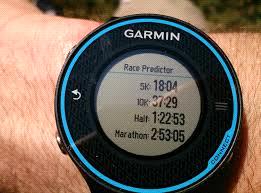If you would like to purchase a membership or subscription to ERM, click here.
All current subscribers will get their sign in code via email.
This issue was a lot of fun to produce. First of all, I was given the opportunity to cover the Falmouth Mile before I went off to run the New Balance Falmouth Road Race this year. The Falmouth Mile is not as popular, but the folks in Falmouth are hoping to raise awareness about this event – since many elite athletes compete in this race. I’ve covered this race for two years now, and thoroughly enjoy watching the athletes.
Before and after the New Balance Falmouth Road Race, I was able to get some photo coverage of the wheel chair athletes and others. It was a thrill to see Krige Schabort, who I met last year. Schabort, who is featured in this issue, is one the world’s best renown wheel chair athletes who has an extensive resume including having competed a the Kona Ironman race as well as countless others in more notable endurance-distance races.
Aside from preparing a race recap on the Falmouth Mile, I covered some of the athletes who competed at the Badwater 135 race this year. The course had to be altered this year after much controversy, thanks to the National Park Service. Two new winners emerged, the veteran internationally-recognized endurance runner, Harvey Lewis, and newbie Aly Venti, who, unlike Lewis, had never competed at Badwater before.
While 100 athletes were preparing for their Death Valley experience two other athletes, Lisa Smith-Batchen and Kenneth Poser (who is coached by Batchen) broke records this year for their racing efforts in Death Valley. Batchen, 52, became the first woman to ever finish a Quad Badwater (yes that’s four times up and back through Death Valley). Her student, Kenneth Posner, completed the Double Badwater in record time, beating Marshall Ulrich’s time. Ulrich is also a Quad Badwater finisher.
This issue boasts a couple of new sections. We cover both International and Regional news. Ghislain Marechal of Brussels set out to challenge himself and raise money for children’s causes. Like Batchen, who raises money and awareness for her Badwater4Goodwater campaign, Marechal developed his X Challenge to complete a DECA Iron experience in Europe this year as we speak during the month of September, 2014.
Regionally, I had the pleasure of interviewing Rick Amernick, founder of the DC Capital Striders, a prolific running group in the DC area. The group now has training runs in Virginia. I met Amernick in person for the first time at the North Face Endurance Challenge in Virginia this June. He’s recently transitioned into ultra-running and completed his first 50K this June.
There are a few other articles in this issue which were just a thrill to produce. When Eric Friedman, a sky diver/runner contacted me about his Sky Dive Run challenges I got back in touch immediately. Of all things – combining Sky Diving and Running! Read and relish this piece!
We have our fourth article in a series by Jay Markiewicz on Mental Training. Markiewicz has become a staple for the magazine in Coaches Corner. We also want to introduce our writer, John Glynn, who had the task of interviewing some of the world’s most prolific names in endurance racing – like Wayne Botha, who we feature in this issue for his world record achievements in barefoot running. Glynn, who is an important asset to ERM wrote an extensive piece on Hitting the Wall – definitely a good read for all athletes, new and veteran alike.
So, Wayne Botha, who is on our cover this issue achieved two barefoot records in one day for one race! The South African born runner set out a goal to get the World Records in barefoot running for two distances and achieved his goals. Like so many of the runners we interview, he, like so many others, put in his head that he would succeed. Guess what? He did!
I want to thank all the folks who contributed to this magazine.
Best Regards,
Alix
Alix Shutello, President and CEO
[email protected]
]]>
Philly Cycling Classic Concludes Its Second Year
 Philadelphia has always been at the forefront of cycling in the United States, but the 2013 Parx Casino Philly Cycling Classic promised to revolutionize the local cycling scene and “bring renewed energy, fresh ideas and passionate leadership to start a new tradition and establish a new identity for Philadelphia in pro cycling.” Having just concluded its second year, has the Philly Cycling Classic been successful so far?
Philadelphia has always been at the forefront of cycling in the United States, but the 2013 Parx Casino Philly Cycling Classic promised to revolutionize the local cycling scene and “bring renewed energy, fresh ideas and passionate leadership to start a new tradition and establish a new identity for Philadelphia in pro cycling.” Having just concluded its second year, has the Philly Cycling Classic been successful so far?
The Philly Cycling Classic was established because it recognized a need for a better platform for Philadelphia’s pro cyclists. For years, many cyclists had complained of the blatant sexism in cycling. Tales of easier courses to lower professional wages have emerged, painting a startling picture of an industry that gets away with sexism on a daily basis. Emphasizing equality – rewarding women’s races the same purse as men’s races – above else, the Philly Cyclic Classic was successful in shifting away from longstanding traditions in pro cycling, allowing men and women to compete on equal terms for the first time.
 The race was also sponsored by Parx Casino, the leading casino in Pennsylvania in terms of revenue. The success of the event has led to great returns for the casino, as its exposure in the event as a name sponsor has allowed for it to become a well-known brand in the community. Exposure to the local community is of utmost importance in today’s congested casino industry. Since internet gambling was established in 1996 with CryptoLogic’s launch of Intercasino, land-based casinos have struggled to stay afloat – a fact that casino mogul Sheldon Adelson has repeatedly pointed out. Parx Casino has certainly done a great job of finding an alternative way of creating brand awareness while tapping into one of the community’s shared interests.
The race was also sponsored by Parx Casino, the leading casino in Pennsylvania in terms of revenue. The success of the event has led to great returns for the casino, as its exposure in the event as a name sponsor has allowed for it to become a well-known brand in the community. Exposure to the local community is of utmost importance in today’s congested casino industry. Since internet gambling was established in 1996 with CryptoLogic’s launch of Intercasino, land-based casinos have struggled to stay afloat – a fact that casino mogul Sheldon Adelson has repeatedly pointed out. Parx Casino has certainly done a great job of finding an alternative way of creating brand awareness while tapping into one of the community’s shared interests.
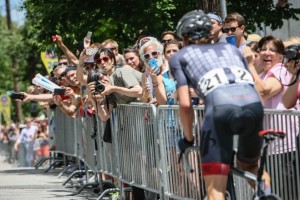 More than anything, the Philly Cycling Classic has served to bridge Philadelphia’s towns together. With a course that ran through the communities of Manayunk, East Falls and Fairmount Park, in plain view of all the members of the community, the event became a shared experience that everyone in Philadelphia could be proud of. Mustering a sense of community that is seldom seen in races, the Parx Casino Philly Cycling Classic has certainly accomplished what it set out to do: renew interest in pro cycling in Philly, and generate a new notion of what it means to be a pro cycler in Philly.
More than anything, the Philly Cycling Classic has served to bridge Philadelphia’s towns together. With a course that ran through the communities of Manayunk, East Falls and Fairmount Park, in plain view of all the members of the community, the event became a shared experience that everyone in Philadelphia could be proud of. Mustering a sense of community that is seldom seen in races, the Parx Casino Philly Cycling Classic has certainly accomplished what it set out to do: renew interest in pro cycling in Philly, and generate a new notion of what it means to be a pro cycler in Philly.
Sources:
]]>The highlight of my race this year was not the race itself (even though the weather was perfect), but what came afterward.
 I couldn’t help but notice Dick and Rick Hoyt at the awards ceremony. I am not one to go up and ask for photos but after about 45 minutes of standing right next to them I asked for a picture. Dick and I struck up a conversation; talking about life and running. I was humbled that he was willing to talk to me. Here is what I’ve learned:
I couldn’t help but notice Dick and Rick Hoyt at the awards ceremony. I am not one to go up and ask for photos but after about 45 minutes of standing right next to them I asked for a picture. Dick and I struck up a conversation; talking about life and running. I was humbled that he was willing to talk to me. Here is what I’ve learned:
Has Dick Hoyt (age 74) Retired? Yes (and no). He’s done with the Boston Marathon and other triathlons. There may be a couple of 5ks left, but he’s going to give his body a rest……which leads to the next question?
How many races has he done? 1100 races in his estimation. I’d give my body a rest too!
Will Rick Hoyt (age 52) continue to race? Yes. Another member of Team Hoyt will carry the torch!
Next appearance for the dynamic duo? The Butterfly 5K in North Attleboro, MA on August 24, 2014.
Thank you Dick, for giving me some time today.
]]>
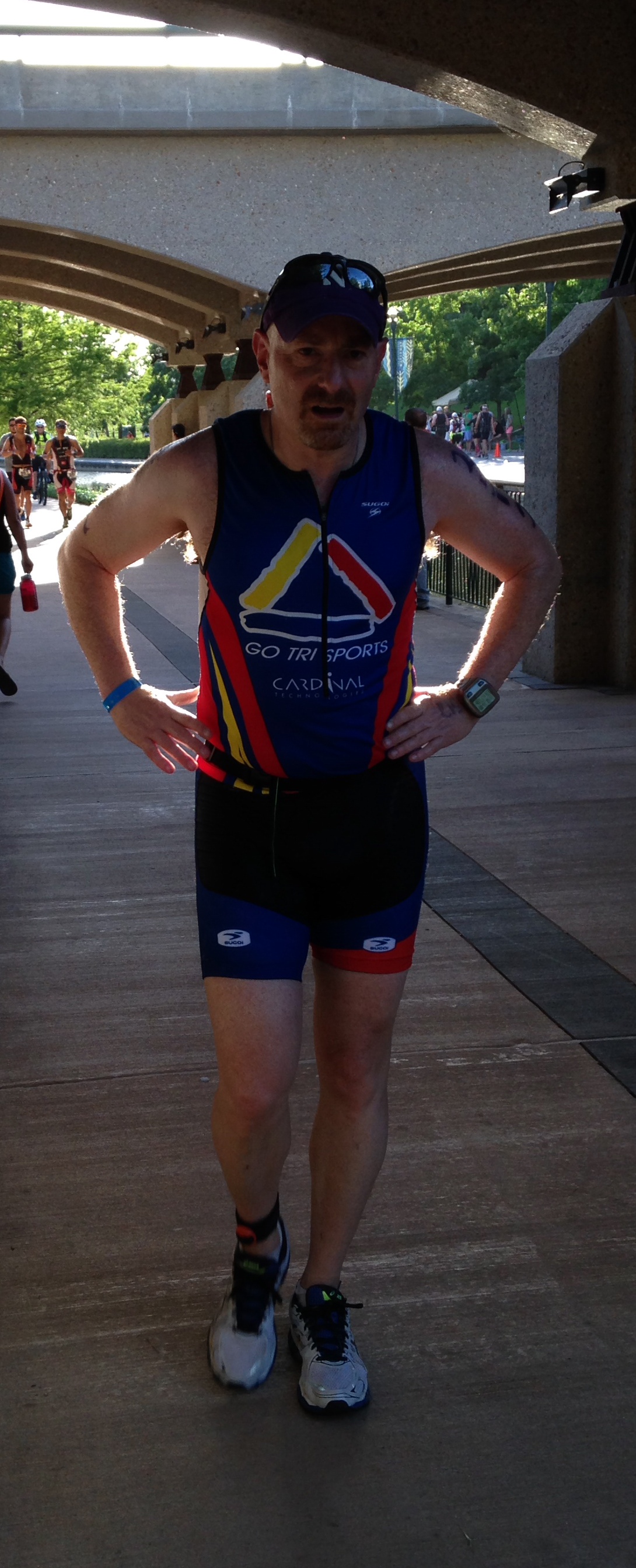 Pain, ache, discomfort, irritation, distress, soreness. Disappointment, displeasure, disenchantment, frustration, regret.
Pain, ache, discomfort, irritation, distress, soreness. Disappointment, displeasure, disenchantment, frustration, regret.
I trained 13 months for my most recent Ironman race. It was a great first 8 months: I was down from 197 to 166 pounds; my climbing on the bike was comfortable; I ran a 5K race averaging 7:45 per mile. I was cruising and setting myself up for a great race.
I lost my focus. Foreshadow some pain…
December came with a vacation in Aruba. Christmas and New Year’s with family in Michigan and the associated party, food, and not-nutritive caloric intake. Training all of a sudden took a back seat to my life. I missed workouts midweek. I got lazy. Foreshadow some pain…
It is a bizarre feeling to know that you are about to experience a great deal of pain. I had many opportunities to prevent it from happening: I could have put a hold on the race, or put it off for another year. I didn’t.
You can’t race Ironman without the requisite uber-focus. I didn’t have it. I consumed some V8 juice during the race, but mistakenly bought “spicy” rather than regular. (What a surprise at the 56-mile point on bike.) I forgot to check my brakes (rubbing until mile 25 on the bike). I was late into the water (gun had gone off and I was not in yet) and swam in a pack with no clear water for 2.4 miles. I finished the swim 15 minutes behind schedule. Begin mental pain.
There is something to be said for those of us who know there is a pile of pain coming and push through. Sure, I have three full IMs under my belt and never a DNF; but when I realized what was happening, believe me, it took every ounce of mental fortitude I have ever mustered to finish.
Pain, ache, discomfort, irritation, distress, soreness. I’ll leave the swim alone for now, it was a rookie error. (Get your wetsuit on early and get in the water.) The real pain started at mile 20 in my lower back and hamstring. Could not understand why I was going 17 mph and not 20 mph on the bike. I finally began to do non-fitness-based triage and began inspecting bike. I looked down and saw BOTH breaks rubbing. Quick actions flipped them open, increased quickly to 20 comfortably – but it was too late, and I knew it. Luckily the pain went away for a while after the brake rubbing was fixed, and I just had a dull ache leading to the IM normal discomfort. It progressed to mile 80, where I could not think of anything other than just getting off the bike. The thought of running a marathon, even though it violated my mantra of Faith, Pace, Focus, Strength (I should have been focusing on the bike), was almost too much to bear. Isn’t it remarkable how mental distress can enhance pain? Seeing my girlfriend and my family at mile 100 was a short, welcome, and fleeting consolation. I knew soreness would be the order of the day on the run (as well as the following few days). All I could think of was getting off the bike. I finally finished at slightly less than 7 hours, 45 minutes slower than scheduled.
Disappointment, displeasure, disenchantment, frustration, regret. I was now an hour behind my planned time. It is hard not to let the disappointment run rampant, but I trudged along running 10:45s as if on schedule. The first three miles were great, next two curious, next three challenging, and then the not-so-surprising “uh-oh” and I was done at mile 14. I walked the last 12 miles with the worst pain on the planet. The kind of pain that no amount of Advil will cure. I was not going to PR. I was not going to revel in 13 months of great training (more or less). I was, at this particular point, not sure I was going to finish. Calves cramping, quads screaming, hips giving out and all I could do was walk. My family was very supportive, as was my soon-to-be fiancée, Laura. Luckily I had her to walk the last 12 miles with me, as well as my teammate Anthony Fleming, who ran into similar challenges at mile 14. Ironic, but welcome, company.
I could barely feel my heels from the blisters. We varied from intense conversations about how to handle the displeasure of a bad race and the long way to go, the disenchantment of a race which seems so amazing prior to the start and the frustration of having your body fail you after you thought you prepared it. Anthony and I compared notes of missed weekday workouts and the regret we had for blowing off training days. It is hard to see the cumulative effect of all the missed days, even if they are not so many. By this time we knew we were going to finish the race, so a first DNF was not a possibility. Perhaps that gave us some solace. We considered trying to start running, but came to the conclusion that we were not sure we could; walking was pretty painful as it was, and what if those cramps that we were barely holding at bay overtook us and prevented us from finishing? That would be too much to bear. So, walk we did. Seeing so many family members and good friends on the course kept me going. Period. I had a huge support network.
How will I handle this emotional pain? How can I push through the physical pain? How mortifying would a first DNF be? Pain, ache, discomfort, irritation, distress, soreness. Disappointment, displeasure, disenchantment, frustration, regret. All of these feelings and emotions streamed through my brain. Perhaps I knew, subconsciously, after the gun went off and I was not yet in the water, that the day was sunk. Rookie mistake, and I am no rookie; get in the water and wait. Perhaps I knew after the brakes on my bike were rubbing for 20+ miles that my marathon was sunk. Rookie mistake; ALWAYS do a quick check on the bike in transition. Perhaps I should have kept running and not walked with my girlfriend and teammate, and MAYBE would have had a PR. But I’ll say without hesitation that walking with them was what got me through. I could not bear to have a DNF in my racing, so that one I’ll take.
I don’t care how I feel. I don’t care how much I hurt. I will not DNF. Whatever it took to not DNF, it allowed me to push through the incredible disappointment of a serious IM bonk and the very painful physical aspect of Ironman. What did I learn?
- Get in the water.
- Check your brakes.
- Have a support team. The bigger the better.
Never again, I said. No more Ironman. I have finished three. Never again. I am still saying this one month later. No more. Maybe a half Iron. Definitely more triathlon. But I am done with Ironman…for now.
I am still, Not Yet on the podium.
This article was authored by Earl Furfine
]]>
While these watches can’t stop you from pulling a hamstring or twisting an ankle, they certainly promote clever training, enhance the ability to recognize faults, and help prevent a runner making the same mistakes over and over. After all, isn’t insanity defined as the process of repeatedly committing the same action and hoping for different results?
GARMIN Forerunner 220
 Initially, if you happened to be in the market for a rather simplistic, easy-to-operate watch, the Forerunner 210 was Garmin’s go-to product. However, with time comes technology, and with time came the Forerunner 220. For any fans of HBO’s late, great TV show, “Entourage”, Vince is definitely the 220 here, while Johnny is the older, less desirable 210. Not only is this wristwatch far more attractive, it’s also sharper and lighter. While it still maintains some of the lovable, simplistic elements of its predecessor, the 220 offers us an opportunity to broaden our horizons and take today’s run to a different level. Maintaining the lengthy battery life of the Forerunner 210, Garmin decided to adjust the wardrobe, so to speak, opting to upgrade comfort and efficiency while downgrading the bulk. The Bluetooth connectivity coupled with slick touch controls make the 220 one of the most impressive watches around. In addition to its improved functionality, the Forerunner 220 tracks your personal records and, via Bluetooth, offers the option of social media sharing, all helping to solidify Garmin’s stellar credibility.
Initially, if you happened to be in the market for a rather simplistic, easy-to-operate watch, the Forerunner 210 was Garmin’s go-to product. However, with time comes technology, and with time came the Forerunner 220. For any fans of HBO’s late, great TV show, “Entourage”, Vince is definitely the 220 here, while Johnny is the older, less desirable 210. Not only is this wristwatch far more attractive, it’s also sharper and lighter. While it still maintains some of the lovable, simplistic elements of its predecessor, the 220 offers us an opportunity to broaden our horizons and take today’s run to a different level. Maintaining the lengthy battery life of the Forerunner 210, Garmin decided to adjust the wardrobe, so to speak, opting to upgrade comfort and efficiency while downgrading the bulk. The Bluetooth connectivity coupled with slick touch controls make the 220 one of the most impressive watches around. In addition to its improved functionality, the Forerunner 220 tracks your personal records and, via Bluetooth, offers the option of social media sharing, all helping to solidify Garmin’s stellar credibility.
Price: $220
Garmin Forerunner 620
Like Usain Bolt off the block, Garmin have been running the GPS sports watch game at a ferocious pace. Nevertheless, even with their impeccable history, the 620 series is simply a stunning slice of elegance. Boasting a color display and high-resolution touch screen, the wrist piece delivers essential biometric data in a marvellously vivid manner. The 620 is the only watch that delivers information[C1] , such as run fluctuation, a feature that helps you gain a clearer understanding of biomechanics. Weighing a mere 1.6 ounces, Garmin’s magnum-opus features Bluetooth and WiFi, along with an extremely snug hinged band.
The science of running is fascinating, a fact that the 620 acknowledges. When the wristwatch is used with a heart rate monitor, a runner is presented with vital statistics, most notably an approximation of your VO2 max.
Garmin Forerunner 620 – Price: $400
Garmin Forerunner 620 w/HRM-Run - Price: $450
Polar V800 GPS
 Successfully designing and producing a great product might sound straightforward, but many companies find it a difficult, highly complex affair. But the V800, Polar’s beautifully functioning watch, combines numerous features into one aerodynamic package. Not only is it a great-looking product, the V800 also boasts integrated GPS and observes your movements 24 hours a day, which assists in compiling tailored training and recovery data. Tracking your speed and distance, the GPS also maps your course, and, via its integrated barometric pressure sensor, the V800 offers precise altitude analysis. In addition to boasting a battery life that can last close to 50 hours in low-powered GPS mode, Polar’s impressive device is extremely light and comfortable to wear.
Successfully designing and producing a great product might sound straightforward, but many companies find it a difficult, highly complex affair. But the V800, Polar’s beautifully functioning watch, combines numerous features into one aerodynamic package. Not only is it a great-looking product, the V800 also boasts integrated GPS and observes your movements 24 hours a day, which assists in compiling tailored training and recovery data. Tracking your speed and distance, the GPS also maps your course, and, via its integrated barometric pressure sensor, the V800 offers precise altitude analysis. In addition to boasting a battery life that can last close to 50 hours in low-powered GPS mode, Polar’s impressive device is extremely light and comfortable to wear.
Polar V800 GPS – Price: $499.95
Timex Ironman Run Trainer 2.0 GPS Watch
 The Timex Ironman Run Trainer 2.0 with GPS and Heart Rate Monitor boasts some notable features, from its GPS function, which measures pace, speed and distance in real time, to its 8-hour battery life in full GPS mode. Weighing in at 2.3oz, the Run Trainer comes with easily customizable settings and a digital 2.4 heart rate sensor.
The Timex Ironman Run Trainer 2.0 with GPS and Heart Rate Monitor boasts some notable features, from its GPS function, which measures pace, speed and distance in real time, to its 8-hour battery life in full GPS mode. Weighing in at 2.3oz, the Run Trainer comes with easily customizable settings and a digital 2.4 heart rate sensor.
Timex has created a watch worthy of our attention. Featuring high-resolution screen display, the lustrous Run Trainer offers a perceptive menu-based interface that assists in recording your pace and distance, while also providing pace indicators and interval feedback. If these features aren’t impressive enough, perhaps the inclusion of independent nutrition and hydration signals politely encouraging you to re-fuel might entice you into purchasing the product. When you’re done admiring all these qualities and actually go for that glorious run, you can upload your workout and review stats using the online diary powered by Training Peaks.
Price: $219.95
 The Ambit2 R running-focused watch, an expansion of the Ambit2 range, offers a lower-price product without skimping on quality. A sophisticated product, Suunto’s beautifully designed watch allows you to record heart rate data, distance, pace and cadence. The integrated GPS and wrist accelerometer coupled with an altimeter are all decidedly inspiring features, especially the latter, as it presents accurate elevation statistics and a 3D compass that provides the runner with course navigation for ascertaining and trailing new routes.
The Ambit2 R running-focused watch, an expansion of the Ambit2 range, offers a lower-price product without skimping on quality. A sophisticated product, Suunto’s beautifully designed watch allows you to record heart rate data, distance, pace and cadence. The integrated GPS and wrist accelerometer coupled with an altimeter are all decidedly inspiring features, especially the latter, as it presents accurate elevation statistics and a 3D compass that provides the runner with course navigation for ascertaining and trailing new routes.
Price: $300
This article was written by John Glynn
]]>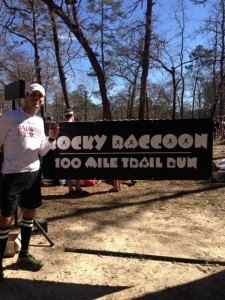 State Trooper Larry West Will Run the Boston Marathon to Support Kids with Cancer
State Trooper Larry West Will Run the Boston Marathon to Support Kids with Cancer
By Alix Shutello
After mistakenly running off-course in his second marathon, state trooper Larry West ran just short of 28 miles. The race director of the Gusher marathon in Beaumont, Texas proclaimed, “You just ran your first ultra.”
And from there, an ultra-runner was born – all due to a traffic error in a local marathon. West then started researching endurance races and training for longer distances. Two years later, in 2011, he ran the Rocky Raccoon 50 in Huntsville, Texas…but he had his heart set on going even farther.
“While researching ultra marathons, I became captivated by the Badwater ultra marathon in Death Valley. I was invited to pace for veteran Badwater runner Cheryl Zwarkowski, provided I finished my first 50-miler.”
The problem was, the Rocky Raccoon 50-miler was so hard, West proclaimed he would never run again.
“Mile 46 was and is still to date the worst moment physically of my entire life,” West said. “However, once I finished and recovered, I signed up for three 100-milers in an attempt to qualify for Badwater within one year (ultimately, it took me one and a half years). Meanwhile, I paced Cheryl at Badwater the summer of 2011, and I ran my first 100-miler at Arkansas Traveler 100 in October of 2011.”
 West went on to run Badwater in 2013, but not before he saw the tragedy at the Boston Marathon in April and was compelled to do something to help. Fortunately, he came upon a small article in “Runners World” that included information on an organization called Cops for Kids with Cancer. Being in law enforcement and having run three 100-milers, West felt the 2014 Boston Marathon might be an opportunity to use his ability to run for others, and reached out to the group.
West went on to run Badwater in 2013, but not before he saw the tragedy at the Boston Marathon in April and was compelled to do something to help. Fortunately, he came upon a small article in “Runners World” that included information on an organization called Cops for Kids with Cancer. Being in law enforcement and having run three 100-milers, West felt the 2014 Boston Marathon might be an opportunity to use his ability to run for others, and reached out to the group.
“The charity typically gives each family $5,000 for those involved directly in the care of children with cancer. Their website is http://copsforkidswithcancer.org,” West said.
There is a website set up for the charity: http://www.crowdrise.com/CFKWC2014BostonMarathon/fundraiser/Mile46
Videos with a local story on Larry are at: https://www.youtube.com/watch?v=1q-6pTyQgUw
]]>By Earl Furfine
Hi, Endurance Racing fans. I trust everyone is getting ready for a great season. I have just completed this year’s first century ride, the MS Breakaway from Miami to Key Largo, in preparation for Ironman Texas. A very well-run ride: 100 miles completed Day 1 and 50 Day 2, followed by a 90-minute run. Not a bad weekend of training! Speaking of training and racing, we here at ERM thought it might be nice to share my top 10 training and racing tips. Most of these you have already heard or even followed, but it is always helpful to get a refresher!
1. Keep your pace early, and push near the end on long training rides. I tend to fall into pace groups that are a little fast for me. I’ve found that if I keep my HR Zone where my coach has advised for the first 70 miles, then try to hammer with a faster group for the last 30, I get a much greater benefit from the workout.
2. Manage your heart rate on the run. I am amazed at how many runners (and triathletes) can’t keep their heart rate down on climbs. By simply keeping the same cadence and shortening up your step, you will keep your heart rate down – and you’ll be amazed at how successfully you can climb even the most painful hills.
3. Keep up with your nutrition. This sounds like a simple plan but is often poorly executed. I tend to get behind on my hydration, particularly during Ironman; so I now force myself to drink every 15 minutes, as much as I can take in, up to one bottle an hour. I use sports drinks with 300 (plus or minus) calories and supplement with gel blocks. It takes a while to experiment with what you can tolerate, but have a plan on race day and don’t try anything new.
4. Flat Coke is the bomb! I was surprised when my coach mentioned that they hand this out at Ironman® rest stops. It settles your stomach (I get GU Belly on some occasions) and gives you a quick lift. Given that it is at every mile stop, the quick lift normally lasts until just about the next stop.
5. Lots of lube before, during and after the bike (enough said, and no I am not talking about your bike chain).
6. Bring fans!! I have never raced Ironman with fewer than 10 supporters. It is absolutely the way to go, especially on the run when you begin to tire. Knowing you will see a smiling, supportive face is better than any energy bar.
7. Advil. (This may not be for everyone). I normally take a few between the bike and run. Of course, consult a doctor if you are unsure.
8. My own personal rule: No Alcohol. I stop all alcohol intake 3 months out from an Ironman-distance race. I know it helps my training and recovery, but more importantly, it begins the “mind over body” training that I need during race day.
9. Carry something inspirational. I have a small gift from my girlfriend that I wear around my neck during the race. It reminds me of the sacrifices she has made for me to be able to race and provides much-needed motivation during the tough parts (mile 80 on the bike is usually mine!).
10. Have a mantra! Anyone who has seen my column knows mine: “Faith, Pace, Focus, Strength”. Faith in my training; keep my desired pace during the race; focus on the event I am currently on; and when all else fails, remind myself (our selves) we are Ironmen and women, the most mentally strong athletes around.
Everyone have a great race season. I am still, not yet on the podium…
“Faith, Pace, Focus, Strength”
]]> Having last been in the U.S. to compete in the Lake Anna Triple Triathlon, Christine decided a 9-year lag was enough…and back to the U.S. she came, to do the Quintuple Triathlon – and prove to herself that she could do it.
Having last been in the U.S. to compete in the Lake Anna Triple Triathlon, Christine decided a 9-year lag was enough…and back to the U.S. she came, to do the Quintuple Triathlon – and prove to herself that she could do it.
By Alix Shutello
Christine Couldrey is addicted to distance. In October 2013, “Kiwi” (as she’s known to her friends) committed to competing in the Quintuple Anvil Triathlon – the equivalent of five Ironman distance races.
The Quintuple Anvil Triathlon, which took place from October 8-13, 2013, at the bucolic Lake Anna State Park, Virginia, USA, draws endurance triathletes from all over the world. Last fall, Couldrey traveled from Australia to compete in the longest race of her career.
“I went so far as to committing to sharing a cabin in Lake Anna State Park to use as a base during the race. The conscious part of my brain was not convinced, but rationalized that logistically it would be easy, I knew the course, I could borrow all the little useful things that one needs from friends in the DC area,” she said.
Couldrey, who lives in New Zealand, has a lot of friends in the endurance world in the United States; including her friend, Aaron, who lives in DC and has shared many any ultra experiences with her. She believed he could be convinced to come and crew for her. She also has a longtime history and friendship with race director Steve Kirby – and when she heard there was a quintuple, she called to confirm that he was offering a race that long…and then got to training.
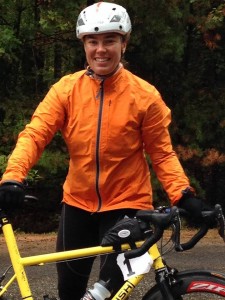 “In an ideal world, if one were going to do a quintuple Ironman, one would start training for it a year in advance – not spend weekends in the summer beekeeping, be involved in buying and selling properties, have minor surgery, be training for a major race during the dark, wet, windy months of winter in the Waikato. Sad to say, I didn’t manage to avoid any of those situations,” she mused.
“In an ideal world, if one were going to do a quintuple Ironman, one would start training for it a year in advance – not spend weekends in the summer beekeeping, be involved in buying and selling properties, have minor surgery, be training for a major race during the dark, wet, windy months of winter in the Waikato. Sad to say, I didn’t manage to avoid any of those situations,” she mused.
But Couldrey is no stranger to competing in multiday endurance races, having been involved in the endurance scene for close to 20 years. To prepare for the quintuple, she trained through the winter in sun, rain, wind and hail, often on her bike with her training buddy Annette. She also (for the first time) hired a running coach, to try to make her running more efficient.
“The coaching made a world of difference. I did my best to be a good student, work hard on my form, and it paid off,” she said. “While so many of my runs were in terrible weather, I was now able to run with less trauma to my knees and legs – and while I was very slow, I comforted myself with the knowledge that I had so much more running experience behind me than I did when I attempted the double and triple Ironman races at Lake Anna in prior years.”
She remembers how terrible the suffering was when she ran two and then three marathons during the double and triple triathlons, and wondered if she would be able to suffer through five. A mantra that her running coach, Mark Sutherland, had taught her was, “I will remain calm and positive at all times.” Couldrey had found this very useful during the Northburn 100-miler she ran a couple of years before. “Each time I struggled on a long run, I would remind myself of this, and carry on,” she said.
Kiwi started training a mere three months before the Anvil Quintuple, while camping on Whitehaven beach in Australia, which, she argues, is “one of the top 10 most beautiful beaches in the world.” She trained by swimming the 7-kilometer length of the beach, with the company of fish, stingrays and even the occasional little reef shark.
“I figured the swim was only 19 kilometers, and I knew I could do 12km from the triple, and it was going to be, by far, the shortest leg…so it deserved the smallest amount of training – right?” she said. But as race time approached, Couldrey wondered whether she had done enough. “How do you know how much is enough for a race of this length? I wouldn’t be able to answer that question until the race was over.”
Couldrey had spent many of the training hours calculating speed and formulating plans A, B and C for how the race would unfold. Aaron, her friend in DC, had also taken a very mathematical approach for her – basing his estimate on time needed for each discipline on times in previous races, working out what sort of scaling factor would be needed and then calculating the estimated total time required, presenting it to her in graphical form. It looked as though the 120 hours allowed by Steve Kirby would be enough, but there would likely not be much spare time (most quintuple races allow 144 hours).
“My main goal was to finish in under 120 hours; anything better than that would be a bonus,” she said.
That meant that after she started the quintuple at 7am Tuesday morning, October 8, 2013, she would finish by 7am Sunday morning, October 13, in her “best-case scenario” – or even by midnight or 1am on Sunday morning, so that she and her team could all go to sleep for the night and be done with it.
With the time for serious training over, Couldrey flew to the USA two weeks before the race, to give herself time to get organized before the competition began.
In a race like this, sometimes slow and steady wins the race, because the thought that you have 4.5 days left to compete – let alone 4.5 hours in one of your swim, bike, or running phases – can be hell on the mind. Couldrey went on to complete the swim phase in 6 hours and 40 minutes. Then it was on to the bike phase, 900 kilometers done 112.5 times over an 8km loop. Couldrey reminisced how difficult that up-and-back loop was 9 years ago when she competed in the triple, and how much easier it is training at home around Lake Taupo.
“As the hours go on and on, the real competition starts for all the athletes as you switch back and forth between competing against others and competing against yourself. There is a constant need to keep mentally focused as the days and nights blend together and you begin to rely more and more on your crew to feed you, get you to sleep, feed you, get you back on to the bike or back on your feet,” Couldrey related. “In the plan, I was going to sleep for 3 hours, between about 1:30 and 4:40am. I don’t think I quite made it to 1:30 before deciding I was too tired to carry on (again, worried about crashing my bike), but it was pretty close. A shower for the first time in 44 hours, some pasta and into bed. Three hours of glorious sleep. For the first time in the race, I slept solidly and deeply. Three hours later, the sleepiness of the previous day was forgotten, and after some porridge I was out there again to finish up the bike loop.”
After the bike phase was finished, it was Friday; and now Couldrey had two more days of competition to get her over the finish line. Now came 65 running laps – or 5 marathons – she had to endure. The first two marathons were relatively easy, but into marathon three, things seemed to slow down.
“With the coming of darkness, came some tiredness…and with tiredness comes a lack of patience, and with that, the pain becomes suffering,” Kiwi said. “While it wasn’t too bad until the last lap of the third marathon, lap 39/65 was perhaps the worst lap of the entire run. I struggled my way up to the turnaround, and there I met one of the volunteers, whose name I forget, but who was always so encouraging; and every time he saw me, he made a comment about how I was always smiling – often leaning out the window of his vehicle and saying “There’s that smile!” as he drove past. I said to him, ‘It’s taken 3 ½ days of racing, but my smile has gone!’ – and he wouldn’t accept that.”
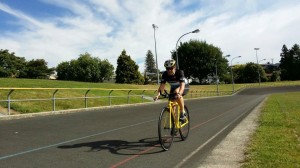 It gets maddening to see competitors finish their respective races, and Kiwi became frustrated at seeing her friends finishing their races – and as she entered marathon 5 she had to keep in mind than many were finishing their triple and quadruple triathlons; she was finishing her fifth.
It gets maddening to see competitors finish their respective races, and Kiwi became frustrated at seeing her friends finishing their races – and as she entered marathon 5 she had to keep in mind than many were finishing their triple and quadruple triathlons; she was finishing her fifth.
But as she neared the end of her race, “something amazing happened.” With 4 laps (10km) to go, Kiwi had the beacon of hope in her hand, as it had gotten dark and her brain completely overrode anything her body was saying. After walking for miles and miles, she wanted to want to run, as opposed to making herself run.
“I didn’t want to walk anymore, I was just going to run….so run I did. I was nearly there. But I still couldn’t let myself think about finishing…I needed to preserve the little bit of patience I had…but all of a sudden, it wasn’t suffering anymore; I had a job to do and I was doing it,” She said.
Even on the last lap, Kiwi couldn’t let herself think of the finish until she had only half a kilometer to go. She said good-bye to the athletes still on the course and finally picked up the flag, and walked the last 100 meters with her friends, listening to her national anthem.
“I was so very incredibly proud of what I had done,” she said.
Right before the race, Couldrey posted a question on Facebook: “How do you race a quintuple Ironman?” Now she knew the answer: One step at a time, with unwavering patience, making sure your brain is happy, separating physical pain from emotions, and trusting your friends.
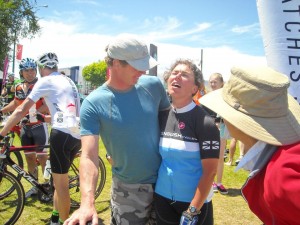 “The quintuple Ironman is by far the hardest thing I have done in my life; but I am so happy that I did it, and I finished hours ahead of my ‘best-case scenario’…what more could I want?”
“The quintuple Ironman is by far the hardest thing I have done in my life; but I am so happy that I did it, and I finished hours ahead of my ‘best-case scenario’…what more could I want?”
To learn more about the Double and Triple Anvil Irons, visit: USAUltraTri.com.
]]>
Fortune 500 Leadership Coach, Sports Performance Coach
Jay Markiewicz: Inner Competitor® Training, Part 2
I recently sat through a lecture on mental toughness. One of the “tools” the presenter offered was to relax when racing. “Just relax.” I looked over at my fellow attendees and saw the frustration on their faces. The same question was running through everyone’s head: “What do I do to attain a state in which I am relaxed?” Seriously, how often do we hear that in order to be mentally tough, one should just “relax”, “focus,” “grit,” “have confidence,” and my all-time favorite be-tough tool – “Overcome your fears!” There it is! Just be fearless! Tell that to a wide-eyed, first-time Ironman triathlete standing on the beach of a mass swim start. “Yo, dude, be fearless!”
I want to share with you a nugget that will change your approach to mental ability from here forward.
Let me frame this nugget: The professional field of “Leadership” is focused on the qualities and characteristics that describe effective leaders; the field of “Leadership Development” is focused on the set of actions, frameworks, and tools to improve as leaders.
Your nugget is that this same distinction applies to athletics – particularly with regard to mental ability. Recognize the distinction between “mental ability” and “mental ability development”. To me, mental ability is focused on the mental qualities and characteristics that describe high-performing athletes, and mental ability development is the set of actions, frameworks, and tools to improve as athletes.
Fearless is a quality. You want the actions and tools to get you to “fearless”.
So with this idea, let’s continue with the actions and tools in our series’ Inner Competitor® training plan to perform better and enjoy the sport more. If you have yet to read Part 1 of this series, you can find it Coaches Corner or in the Jan/Feb 2014 Issue of Endurance Racing Magazine.
To recap what you learned in my first article:
- Your brain is designed to minimize danger and maximize reward. As an athlete, you are often faced with situations your body will determine as requiring “threat response” – thereby minimizing danger.
- When experiencing a threat response, your athletic performance and enjoyment is at high risk (and by the way, when you are at work and in a threat response, your ability to perform your job at a high level is at risk, too).
- The threat response process includes your inner voice and emotions.
- Your competence at managing through the threat response leads to elevated performance and enjoyment.
- The first step to training your brain and gaining competence in managing the threat response is the intentional action of noticing.
Now, ask yourself the following questions:
- What are your three or four main tendencies when performing?
- What data do you focus on when it gets hard? When it’s going great?
- What are the top 10 situations that kick off your threat response?
- What top five things do you find yourself noticing when performing (weather, Garmin data, course, feel, body, etc.)?
Part 2 of your training plan is an expansion of Noticing, summed up with the motto: “Pay attention to what you are paying attention to!” In other words, notice what you are noticing.
I have to admit this is one of my favorite concepts, because it truly is a game-changer. The more competent you become at “paying attention to what you are paying attention to,” the better you will perform as an athlete. Period. Not only will you perform better as an athlete, you may find yourself performing better as a parent, coworker, and boss, too!
Let’s kick-start this level of Noticing. Write down everything you remember from your last workout (this is most likely what you noticed). Ask yourself: What do I remember about the weather, course, equipment, data, performance metrics, body, feeling, thinking, inner voice? This is what you are paying attention to.
The two things you are doing right now to “pay attention to what you are paying attention to” are:
- Taking a moment to look at everything you just wrote down, and recognizing any themes; and
- Listing the top five things you find yourself noticing when performing.
- This is the process of developing awareness.
With practice, you will become aware in real time, as it happens – then the real magic begins! Boom! You will look at your Garmin data and say, “Oh hey, I am paying attention to my Garmin data, hmm” – bringing smack-dab to your consciousness that you are choosing to notice Garmin data.
This concept can feel a little heady at first; stick with it! Physical training stresses your muscles; brain training stresses your brain! When I learned about this concept at Georgetown’s Leadership Coaching program, I was so scrambled that I didn’t know what the heck was going on; I don’t think I had a sensible thought the rest of the day. However, the good news is that with practice, this process becomes second nature.
To see more on why this is important, and to get a sneak preview of Part 3, check out http://innercompetitor.com/video-inner-competitor-at-endorphin-fitness-2/#.UxTrmdxJ-Qd
In the meantime, give yourself grace and have a lighthearted approach to your mental ability development. At the end of the day, enjoyment and performance go hand in hand.
Rock!
Jay
Jay Markiewicz is an endurance athlete and Fortune 500 Leadership Coach, Sports Performance Coach, and founder of Inner Competitor® – an organization that works with clients who want to perform better and enjoy their life more. You can contact Jay at [email protected].
]]>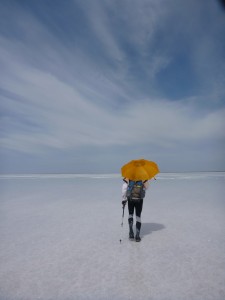 Expedition adventure racing is something of a brutal sport. Competitors typically race through a course of about 500kms over 4-7 days. Throughout the world there are a series of races that make up the toughest and most respected races around, comprising the Adventure Racing World Series. Australia’s one and only expedition race, XPD, stands as a behemoth. It is consistently longer than any other race in the world series, and is renowned as being one of the toughest races of any sort – period. The 2013 race, the Geocentric-run XPD covered 750kms with a course duration of up to 9.5 days. My team – Outer Edge Racing – raced for just over six days, trekking, running and mountain biking for about 22hours a day through the Australian outback and Flinders Ranges.
Expedition adventure racing is something of a brutal sport. Competitors typically race through a course of about 500kms over 4-7 days. Throughout the world there are a series of races that make up the toughest and most respected races around, comprising the Adventure Racing World Series. Australia’s one and only expedition race, XPD, stands as a behemoth. It is consistently longer than any other race in the world series, and is renowned as being one of the toughest races of any sort – period. The 2013 race, the Geocentric-run XPD covered 750kms with a course duration of up to 9.5 days. My team – Outer Edge Racing – raced for just over six days, trekking, running and mountain biking for about 22hours a day through the Australian outback and Flinders Ranges.
By Navigation Expert, Rohan Kilham
It all began 3 months before the race. I assembled an all-male team and we began a very belated training program focusing on trekking at speed, mountain biking on semi-technical terrain and paddling. It is a salient aspect of all adventure races that the course and maps are revealed just prior to the race start, meaning we were none-the wiser as to which discipline would be the most important.
Six weeks out from the race Sean – the team hard man – pulled out due to work commitments, leaving us to find another member. Queenslander Bec Wilson stepped up, and with only a few weeks to go, we changed our entry to the premier mixed division. It is a curiosity of Adventure racing that the world’s best teams are invariably mixed rather than all male. Indeed in some races only mixed teams are permitted to race – so it was nice to now have a team in the most competitive division.
The race HQ was at Port Augusta, South Africa. Here we attended competency checks, gear checks and briefings. Race bibs were handed out and 20 hours prior to our scheduled departure, we were given our maps. The next day 30 teams from Australia, New Zealand, Papua New Guinea, Japan and Brazil boarded coaches for the race start – the remote Arkaroola.
The race start was preceeded by a ceremony for two adventure racers from team Real Discovery who dies tragically in a sea kayaking accident. After a solemn few minutes on top of Accacia ridge teams followed Real Discovery down to the race start before beginning a 30km rogaine in almost 40 degree heat.
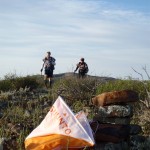 Our team had planned a course through several gorges with some relatively straight forward navigation over several hills and creek-beds. In the stifling heat we slashed our way through sharp undergrowth to the beginning of 20km Gorge. Sweat dried as fast as it soaked my arm-pits and neck, the sun was relentless as it scorched our skin and blistered our lips. After some 4 hours or so we found our first water; a small muddied pool with a dead wallaby on its periphery. We dove in immediately, savoring cold fluid on hot flesh but needed to move on quickly. We ran for a while tussling with the Bivouac Colts and Team Mawson for 3rd place. But as we hit the first transition area, we were in 4th place hot on the heels of the Bivouac Colts.
Our team had planned a course through several gorges with some relatively straight forward navigation over several hills and creek-beds. In the stifling heat we slashed our way through sharp undergrowth to the beginning of 20km Gorge. Sweat dried as fast as it soaked my arm-pits and neck, the sun was relentless as it scorched our skin and blistered our lips. After some 4 hours or so we found our first water; a small muddied pool with a dead wallaby on its periphery. We dove in immediately, savoring cold fluid on hot flesh but needed to move on quickly. We ran for a while tussling with the Bivouac Colts and Team Mawson for 3rd place. But as we hit the first transition area, we were in 4th place hot on the heels of the Bivouac Colts.
We assembled our bikes and headed off into the sunset, but Roland’s chain broke. We fixed the chain and rode through Wooltana station – a flat, arid cattle station of red dirt and bull dust dotted with the pastel greens of saltbush.
The sun slowly set behind us as we rode on, but soon thereafter, Dan began to struggle. He began slurring his words and slowing considerably. He started vomiting and needed a tow. Fortunately, he perked up after an hour or so, but the strain of dehydration and exhaustion were there. We navigated conservatively and moved back to 3rd place. We rode through the night using by lights we travelling some 48kms without a single hill until we found ourselves pushing through soft cattle tracks on bull dust and needed to walk our bikes. After several Km of hiking in bike shoes on the soft red sand we made it to our next transition on the edge of Lake Frome.
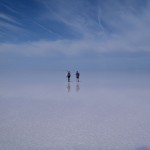 We had no real idea of what this leg would entail. All we knew was that it was a 50+ Km trek on a salt lake. Again we chose a conservative route as we navigated our way to a checkpoint in the middle of several thousand square Km of salty nothingness, before navigating south to the checkpoint. We forged a way though sand dunes and saltbush we hit the lake – a surreal almost 2 dimensional landscape of pure white.
We had no real idea of what this leg would entail. All we knew was that it was a 50+ Km trek on a salt lake. Again we chose a conservative route as we navigated our way to a checkpoint in the middle of several thousand square Km of salty nothingness, before navigating south to the checkpoint. We forged a way though sand dunes and saltbush we hit the lake – a surreal almost 2 dimensional landscape of pure white.
The surface of the lake was like concrete; hard, lightly textured and dead flat. We very carefully set a bearing for our first checkpoint, navigating on a totally moonless night without a single landmark or contour to help. The experience was a little nerve-wracking. It was crucial we stayed on our bearing if we were a little off, we could walk straight past it.
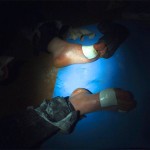 Eventually morning broke, revealing our position. It was like a surreal dream. On all sides was eternity of flatness. The horizon ended in a 360-degree uninterrupted juncture of pale blue and white – no hills, no landmarks and no clouds. After several more hours of trekking we came across an ‘island’ a patch of sand amidst the white. We rested our feet for a while and assessed our situation. The salt was as abrasive as it was intrusive. It had worn its way into our shoes and socks and was causing some savage blisters. Our toes, heels and the balls of our feet were swollen and sore. Blood oozed from toenails, diluted by the leaking serous fluid of engorged blisters. We taped our feet as best we could, had some breakfast and carried on for another 15hours.
Eventually morning broke, revealing our position. It was like a surreal dream. On all sides was eternity of flatness. The horizon ended in a 360-degree uninterrupted juncture of pale blue and white – no hills, no landmarks and no clouds. After several more hours of trekking we came across an ‘island’ a patch of sand amidst the white. We rested our feet for a while and assessed our situation. The salt was as abrasive as it was intrusive. It had worn its way into our shoes and socks and was causing some savage blisters. Our toes, heels and the balls of our feet were swollen and sore. Blood oozed from toenails, diluted by the leaking serous fluid of engorged blisters. We taped our feet as best we could, had some breakfast and carried on for another 15hours.
As the afternoon overtook us we slowed considerably. Bec had begun to vomit due to heat stroke and we were forced to rest with 10 Kms of white salt to go. Of the 30 litres we had brought we had little more than 5 left. We forced 500 mls down Bec’s throat and dripped small amounts of what was left on her neck, head and chest, trying to cool her down. Eventually we were able to set off again. The challenges didn’t stop however. As we headed south we very quickly came across water. It was so hyper saline that it could not dissolve any of the salt that made up its edge – nor could it evaporate easily. With no way of knowing what lay beyond, nor where the waters edge might lie, we forged away straight through it. For 5kms we trapsed through ankle, then knee deep water before arriving at the lake edge. We pulled into the next TA some 20+ hours after beginning. Bec was near collapse, and my mind was shot from focussing on a compass bearing and blank horizon for 20 hours without a break. We agreed to dress our blisters and sleep for 3 hours – a full 24 hours before we had originally planned.
Taking off our shoes was like a horror show. Blisters distorted our feet as if we were deformed. Skin flapped from our toes and heels while blood and serum literally dripped to the ground. Popping our remaining in-tact blisters with a knife was a gruesome task. Like puncturing and overfull sack of pus, they sprayed their contents over our clothes and legs. It was grotesque. The balls of my feet were now detached, my heels – particularly my right – was comprised of a 10 cm flap of wet skin, I had lost the feeling in several toes, some of which were being held together with white tape. The other guys were all missing toenails – casualties of swollen feet – and sported a similar array of skin flaps.
Reality came crashing down. There was very little chance of us finishing a further 140 Kms of trekking with feet like this. Our race was probably over. Earlier on we had jokingly agreed that it would be the finish line or death. Now, with doomed feet, the chance of finishing seemed elusive at best. We agreed that we would go until we physically could go no further. Though we were now racing to survive rather than racing for a place, we agreed we’d keep going until we broke. We were despondent at the thought of pulling out – more so in the knowledge that it would probably be at the beginning of the next trekking leg.
The three hours of sleep we had worked wonders. We got up at about 9 pm and set off several hours later. We had been deliberately slow, having given up on being competitive. However it seemed as though some sort of miraculous recovery was underway. Though we hobbled in pain in our bike shoes, once we were up and racing the pain in our feet subsided. We pushed on with surprising ease astride our trusty two-wheeled steeds.
 Leg 4 was another long flat leg of bull dust and salt bush. Finding the navigation simple we set a fast pace to head into the next transition. It was a relief to be free of the monotony and lethargy of the salt lake, and we raced through the night regaining some lost time in the cool dry conditions.
Leg 4 was another long flat leg of bull dust and salt bush. Finding the navigation simple we set a fast pace to head into the next transition. It was a relief to be free of the monotony and lethargy of the salt lake, and we raced through the night regaining some lost time in the cool dry conditions.
The following leg was a formidable one. It was a 40 Km trek over three small mountain ranges with some difficult navigation on almost featureless plains. Deciding we had nothing to lose we forced our swollen pulped feet into running shoes and set off. I was eager to get as much done in the light of day as we could, knowing that the navigation got harder and harder the further west we went. Our progress was slow – no more than about 2 Km/h – but it was constant. As we hobbled through the day we picked up several more checkpoints before arriving at a water drop.
Here we donned lights, drank deep and prepared ourselves for the hardest navigation of the course. We set off at our slow deliberate pace, Bec slowed a little by her wrecked feet and a new pain developing in her thigh. We wound our way up dry creek beds, paying careful attention to the match of creek direction and map direction. Then we traversed several slopes to a series of mountain tops before coming to our checkpoint in a saddle. Following a crude bearing we then worked our way to a highpoint, then a wide river bed then up several more creek beds to where I thought our next check point would be but after 2 hours of searching it couldn’t be found. Till now my navigation had been solid – as the team’s sole navigator I felt I’d done well – but now, lost in the wilderness it felt like I was wasting everybody’s time. We agreed that we’d sleep for 2 hours and head off just prior to sunrise in search of the mystery checkpoint. The night was clear and cold. We spooned for warmth, shivering beneath a stunning black moonless sky. After 2 hours of frigid rest we roused – just prior to sunrise. We found the checkpoint only a little way north, before we headed into Blilnman – population 22 – for the next TA.
Here we redressed our deteriorating feet and prepared for a straight forward mountain bike. But the trek had damaged our feet more than we could have imagined. Roland and Dan had to cut large swathes of fabric from their bike shoes in order to accommodate their feet. Furious at the imposition, unrelenting agony and the sense of wasted time, Roland set off at a furious pace with Bec on tow. For 30 minutes we set a maniacal pace down bitumen before heading onto some 40kms of dirt on our way into the famous Wilpena. We slowed our pace out of necessity to something more manageable as the heat overtook us and Roland calmed. The next few hours saw us blitz some 7 teams in the space of several hours as we cruised into Wilpena in one of the fastest times in the field. It became the hallmark feature of our race. Fast bike legs followed by agonisingly slow trekking legs.
At Wilpena we wasted time in setting off for the spectacular trek up St. Mary’s peak. It was a relatively straight forward 28km trek on formed paths but we were reluctant none-the-less. Our feet – Becs and mine especially – were excruciatingly sore. We set off via the public toilets – relishing the chance to use a proper toilet for the first time in 4 days. The trek itself was a slow wander through Wilpena pound. Being night we missed the views, catching instead an ink-black sky, littered with a thousand stars, unadulterated by the pale touch of moonlight. Exhaustion was evident. Roland had begun to hallucinate, seeing faces and animals on the track, and Dan was literally falling asleep on his feet. At times he would lurch to one side, as he almost fell asleep while walking.
 As the track climbed and fell it became evident that Bec was struggling. We stopped for a brief rest, and took extra weight from Bec. Stoic as ever though she was keen to push on, at times even attempting a horrible deranged hobbling run. With less than 10 Kms to the TA we would normally have jogged it in 1.5 hours, however as the pain and lethargy overtook us we found it taking us more than double that. From time to time Bec was doubled over, vomiting in pain. Even though we had done all we could, leaving Bec with less than a kilogram of weight to carry, I couldn’t help but feel useless – unable to help a faultering team mate.
As the track climbed and fell it became evident that Bec was struggling. We stopped for a brief rest, and took extra weight from Bec. Stoic as ever though she was keen to push on, at times even attempting a horrible deranged hobbling run. With less than 10 Kms to the TA we would normally have jogged it in 1.5 hours, however as the pain and lethargy overtook us we found it taking us more than double that. From time to time Bec was doubled over, vomiting in pain. Even though we had done all we could, leaving Bec with less than a kilogram of weight to carry, I couldn’t help but feel useless – unable to help a faultering team mate.
Pushing on to the next transition was a pretty gutsy effort on Bec’s part, and it was a huge relief to get to the transition knowing we had done the majority of the trekking. We took 2 hours of sleep in the early morning then jumped on the bikes for a short sprint to a roping section 400m above the ground. We made short work of the 20kms overtaking several teams along the way. From there we headed up to Moonarie, a world renowned rock climbing area, where we ascended ropes to the next checkpoint. It was a brilliant setting. Dangling high on a vertical, almost overhanging wall of blank red rock, I relished the outrageous exposure and spectacular panorama. Despite our position, I felt as calm and relaxed as I had for the whole race. No stranger to rope-work, it was a delight to be free of the bike and trekking poles, if only for a while.
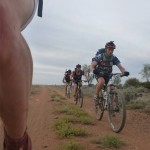 The final push to mid camp was tiring. We pushed hard, knowing that so long as we were on the bike, we were capable of splits in the top 3. It was an exhausting leg though. After several more flats, we came to a steep hike-a-bike. Overcome with the pain in my feet I lagged behind the team as I slowed considerably. In the end Roland had to carry my bike the final few hundred meters up the hill, while I suffered as silently as I could on the ascent. The stiff soles of my bike shoes had slowed me to a crawl, and I felt guilty at holding my team mates up. The roads that made up the following legs didn’t match the maps particularly well at all. From here we bashed our way across country to the next checkpoint, before finding the trail again. After several hours we arrived at Hawker. Here we had a compulsory 6 hr stop. We ate, recharged batteries and attempted to sleep in the baking afternoon sun. Overcome with flies and heat, sleep was a long time coming. We woke at around 8pm to re-dress our feet and head off on a 150km mountain bike leg to Wilmington. Our timing had been a mixed bag. Though we lost sleep in the middle of the day, languishing in our hot windless tent, we were now riding during the cool of night, meaning we had to carry less water and would be less likely to succumb to heat stroke.
The final push to mid camp was tiring. We pushed hard, knowing that so long as we were on the bike, we were capable of splits in the top 3. It was an exhausting leg though. After several more flats, we came to a steep hike-a-bike. Overcome with the pain in my feet I lagged behind the team as I slowed considerably. In the end Roland had to carry my bike the final few hundred meters up the hill, while I suffered as silently as I could on the ascent. The stiff soles of my bike shoes had slowed me to a crawl, and I felt guilty at holding my team mates up. The roads that made up the following legs didn’t match the maps particularly well at all. From here we bashed our way across country to the next checkpoint, before finding the trail again. After several hours we arrived at Hawker. Here we had a compulsory 6 hr stop. We ate, recharged batteries and attempted to sleep in the baking afternoon sun. Overcome with flies and heat, sleep was a long time coming. We woke at around 8pm to re-dress our feet and head off on a 150km mountain bike leg to Wilmington. Our timing had been a mixed bag. Though we lost sleep in the middle of the day, languishing in our hot windless tent, we were now riding during the cool of night, meaning we had to carry less water and would be less likely to succumb to heat stroke.
Ultimately the leg was fairly uneventful. Our feet performed well on the bike legs, and during this leg in particular, navigation was straight forward. We pushed through only slightly slower than the winning team – mountain designs. Just before sunrise I bonked. My legs and body were shot from the 300kms of riding thus far. Somehow though, the sun started a revival, and an hour later I was firing on all cylinders again. Then only 5kms out from the transition Dan began passing out – almost collapsing mid-ride. Dan’s ‘engine’ was unique. He literally required calories every 10 minutes. Despite weighing a paltry 60kgs, he ate more than any of us. It took some fine tuning, but in the end he found a winning formula in the form of Hammer Perpetuem solids: small chalky puks worth 33 calories a pop. One of these every 10 minutes while riding seemed to keep him in remarkable shape. During our 450+ Kms of riding, Dan towed Bec for about 300 of them! We took a few minutes out before pushing on to Willmington.
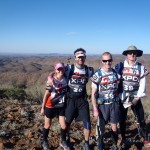 Here we learnt that fierce winds had cancelled the final leg – an 87 Km paddle. Instead a 60 Km mountain bike replaced the final 2 legs. It was a bittersweet ending. Paddling was one of the legs that defined adventure racing. Not paddling felt like cheating. But paddling was also our weakest link, meaning that we had a chance to make up a spot or two in the final leg.
Here we learnt that fierce winds had cancelled the final leg – an 87 Km paddle. Instead a 60 Km mountain bike replaced the final 2 legs. It was a bittersweet ending. Paddling was one of the legs that defined adventure racing. Not paddling felt like cheating. But paddling was also our weakest link, meaning that we had a chance to make up a spot or two in the final leg.
Before that however, the final 50km trekking leg remained – a wandering course through the foothills of Mt Remarkable, then up and over Mt Remarkable itself and down into the small town of Melrose. We resumed our 2kmph pace again picking up several easy checkpoints along the way. All the while we were chowing down on anti-inflamatories and pain killers at maximum dose. As night fell Dan, Roland and Bec began to falter, they stumbled along talking about the snakes on the ground and lights in the trees. Not for the first time this race Roland was hallucinating from tiredness. We bunked down for 2 hours at Scarfes hut. We simply couldn’t justify any more sleep this close to the finish. Heading off again we ascended a 5km ridgeline to a small plateau and the final off-track checkpoint, hidden in a creek bed. Becs feet and leg were ailing, and at times Dan and I had to physically carry her while Roland carried the extra gear. Slung between us we would carry Bec down hills in order to speed up the team.
Roland and Bec were doing it tough though, and as we wandered across a high plateau beneath the summit of Mt Remarkable they began literally falling asleep on their feet. Roland would sway dangerously, while Bec, supported by Dan had her eyes closed, staggering through the undergrowth. At one stage she admitted not remembering the previous hour despite picking up one of our final checkpoints. Struggling to stay awake and to move fast Dan carried Bec for the remaining parts of the 50km trek in an attempt to speed up our progress.
But we were still painfully slow, and 15kms from the end of the trek we found ourselves caught out in the very early hours of the morning. High on the trek, the usually hot weather took a surprising turn, pelting us with strong winds and rain. With people near collapse and hypothermia a real possibility we pushed on to a shelter where we slept for 3 more hours. We spooned for warmth, our mandatory 400 g sleeping bags simply not cutting it in 5 degrees and wet. As the sun dawned we put on wet clothing, ate as much as we could and trekked the final few Kms to Melrose.
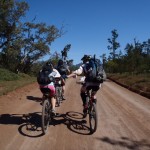 We were one leg from the end. A 60 Km bike ride on bitumen. At the transition we discovered we were an hour behind Team Goldfish and 2 hours behind The Muppets. Backing our biking abilities we hurried to catch them. 20 minutes after arriving we hit the tarmac with blistering pace. We set a pace line and pushed hard. We had to make up about 15kms in a 60kms leg just to make up one place! After a frantic 3 hours we did it. We caught Team Goldfish on the outskirts of Port Augusta and hurried to the finish line.
We were one leg from the end. A 60 Km bike ride on bitumen. At the transition we discovered we were an hour behind Team Goldfish and 2 hours behind The Muppets. Backing our biking abilities we hurried to catch them. 20 minutes after arriving we hit the tarmac with blistering pace. We set a pace line and pushed hard. We had to make up about 15kms in a 60kms leg just to make up one place! After a frantic 3 hours we did it. We caught Team Goldfish on the outskirts of Port Augusta and hurried to the finish line.
No sooner had we overtaken them, than the guilt of pipping someone at the post after 750kms – for 9th place no less – overtook us. We stopped on a corner and waited for Goldfish to arrive. Then at last we crossed the finish line as two teams. Exchanging much deserved congratulations.
In the days following our feet have undergone an odd metamorphosis. For my part the pain of walking subsided as flaps of skin dried up and fell off. Sleep calls me all day long. My body wants nothing more than to lie down and rest. But it will subside. And I know that soon I’ll be training again, desperately hanging out for the next race.
Side bar:
 LAKE FROME IS A SALT LAKE THAT FILLS ONCE EVERY 30 ODD YEARS. THERE WAS A SMALL STRIP OF ANKLE-DEEP, HYPER-SALINE WATER AT THE SOUTHERN EDGE, BUT FOR THE MOST PART IT WAS BONE DRY. THE SURFACE WAS A ROCK-HARD SALT CRUST THAT WAS DEAD FLAT. THE CONDITIONS WERE SO HARSH THAT NO PLANT-LIFE, ANIMALS OR INSECTS CAN LIVE ON OR AROUND THE LAKE.
LAKE FROME IS A SALT LAKE THAT FILLS ONCE EVERY 30 ODD YEARS. THERE WAS A SMALL STRIP OF ANKLE-DEEP, HYPER-SALINE WATER AT THE SOUTHERN EDGE, BUT FOR THE MOST PART IT WAS BONE DRY. THE SURFACE WAS A ROCK-HARD SALT CRUST THAT WAS DEAD FLAT. THE CONDITIONS WERE SO HARSH THAT NO PLANT-LIFE, ANIMALS OR INSECTS CAN LIVE ON OR AROUND THE LAKE.


